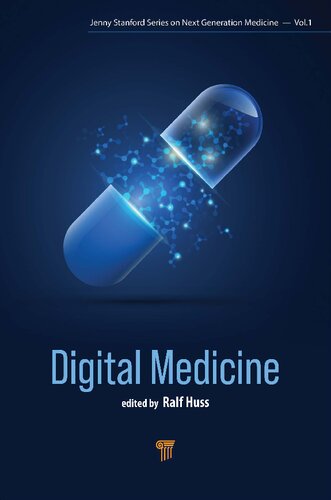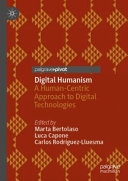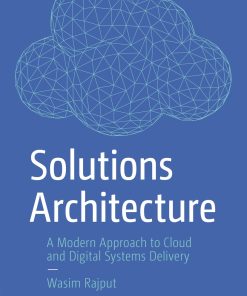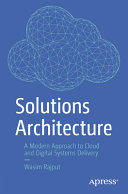Digital Medicine Bringing Digital Solutions to Medical Practice 1st edition by Ralf Huss 1000868974 9781000868975
$50.00 Original price was: $50.00.$25.00Current price is: $25.00.
Digital Medicine: Bringing Digital Solutions to Medical Practice 1st edition by Ralf Huss – Ebook PDF Instant Download/DeliveryISBN: 1000868974, 9781000868975
Full download Digital Medicine: Bringing Digital Solutions to Medical Practice 1st edition after payment.

Product details:
ISBN-10 : 1000868974
ISBN-13 : 9781000868975
Author : Ralf Huss
This book provides an introduction into the field of digital medicine, its wide spectrum of current clinical applications, and the future practice of medicine. With “digital health” and “digital medicine” at its core, it focuses on the combination of therapeutics with modern hard- and software solutions, including artificial intelligence and advanced diagnostic technologies such as augmented imaging and ingestible or wearable (nano)sensors, to provide best patient care. In the four parts of this book, experts in the field have authored use cases and guiding principles on the visualization of patient data analytics and clinical decision support tools, including robotic-guided interventions, as well as nursing research along with palliative and inpatient care. The book also provides examples of “digital medicine” from almost all clinical disciplines together with technical and e-learning solutions.
Digital Medicine: Bringing Digital Solutions to Medical Practice 1st Table of contents:
Part I Digital Science
Chapter 1 Introduction to Machine Learning for Physicians: A Survival Guide for Data Deluge
1.1 Machine Learning: An Overview
1.1.1 Navigating through Concepts
1.1.2 Machine Learning Approaches and Tasks
1.2 Machine Learning for Healthcare
1.2.1 Supervised Learning
1.2.2 Semi-supervised Learning
1.2.3 Unsupervised Learning
1.2.4 Reinforcement Learning
1.3 Limitations, Challenges, and Opportunities
1.3.1 Lack of Data, Labels, and Annotations
1.3.2 Learning across Domains, Tasks, and Modalities
1.3.3 Data Sharing, Privacy, and Security
1.3.4 Interpretable and Explainable Machine Learning
1.3.5 Toward Causally Informed Models
1.4 Conclusion: Quo Vadis?
References
Chapter 2 Data Access and Use
2.1 Legislation
2.2 Data Access
2.2.1 Governance
2.2.2 Pseudonymization and Anonymization
2.3 Data Use
2.3.1 Storage as a Specific Use Case
2.3.2 Data Sharing
References
Chapter 3 Data Integration
3.1 Introduction
3.2 Interoperability
3.2.1 Syntactic and Structural Interoperability
3.2.2 Semantic Interoperability
3.2.3 Process Interoperability
3.3 Extract, Transform, Load Process (ETL Process)
3.3.1 Introduction
3.3.2 Extract
3.3.3 Transform
3.3.4 Load
3.4 Data Provisioning and Data Storage
3.4.1 Data Lake
3.4.2 Data Warehouse
3.4.3 Data Provisioning “On the Fly”
3.5 Data Quality and Data Reliability
3.5.1 Definition and Relevance
3.5.2 FAIR Principles
3.6 Reintegration of Data
References
Chapter 4 Data Analysis in Genomic Medicine: Status, Challenges, and Developments
4.1 Introduction
4.2 Genome Sequencing in Clinical Applications
4.2.1 Read Mapping to the Human Reference Genome
4.2.2 Variant Detection
4.2.3 Variant Annotation
4.2.4 Genomic Variant Information from Primary Literature
4.2.5 Identification of Driver Mutations
4.2.6 Conclusions
References
Part II Digital Health and Innovation
Chapter 5 Ethical Aspects of mHealth Technologies: Challenges and Opportunities
5.1 Introduction
5.2 Ethical Implication and Challenges
5.3 The Ontologies and Epistemologies Shaping mHealth
5.4 Concerns of Accuracy, Safety, and Security
5.5 Support for User Health Decision-Making
5.6 Protection from Physical and Mental Harm
5.7 Increasing Benefit
5.8 Intersectional Benefit and Health Justice
5.9 Conclusion
References
Chapter 6 i-Learning: The Next Generation e-Learning
6.1 What Is e-Learning?
6.2 History and Domains of e-Learning
6.2.1 History of Educational Technology: Teaching Machines
6.2.2 The History of Programmed Learning
6.2.3 History of Computer-Based Learning
6.2.4 History of Cybernetic Learning and Personalized Learning
6.2.5 History of Multimedia Learning
6.2.6 History of Distance Learning
6.3 The Concepts and Technical Domains of e-Learning
6.4 The Driving Forces Behind e-Learning
6.5 e-Learning in Medicine
6.6 What Comes Next?
6.6.1 Lost in Information
6.6.2 Medicine Is Increasingly Ruled by “Big Data”
6.6.3 Information: Seed of a New Age?
6.6.4 Coding: The Next Generation Literacy
6.6.5 Should Every Medical Student Learn to Program?
6.6.6 i-Learning: The Next Generation of e-Learning
6.6.7 What Drives i-Learning?
6.6.8 i-Learning and Medical Information Science (MIS)
References
Chapter 7 Data-Driven Nursing Research: An Overview of Underlying Concepts and Enablers
7.1 Status Quo
7.2 Nursing Data Collection for Research Purposes
7.2.1 Nursing Minimum Data Sets
7.2.2 Nursing Sensitive Indicators
7.3 Interoperability of Data Exchange Across Different Systems and Facilities
7.3.1 Semantic Interoperability
7.3.2 Syntactic Interoperability
7.3.3 Inter-institutional Data Transfer
7.4 Discussion
References
Chapter 8 Designing the Hospital of the Future: A Framework to Guide Digital Innovation
8.1 Sharpening the Vision
8.2 The Conceptual HoF Framework
8.2.1 Patient (P)
8.2.2 Staff (S)
8.2.3 Treatment and Intervention (T)
8.2.4 Logistics and Supply (L)
8.2.5 Management and Organization (M)
8.2.6 Data and Control (D)
8.2.7 Infrastructure (I)
8.3 Evaluation of HoF Dimensions
8.4 Enablers
8.5 The Four-Step Approach
References
Chapter 9 Combining Digital Medicine, Innovative Geospatial and Environmental Data in Environmental Health Sciences to Create Sustainable Health
9.1 Introduction and Setting the Stage
9.2 The Exposome
9.3 Environmental Health Services
9.4 Data for Environmental Health Services
9.5 Measuring Exposomes by Personal Samples, Individual Exposome
9.6 The Role of Earth Observation Data in Public Health Research
9.7 Imitating Natural Exposure Conditions in Human Exposure Chambers
9.8 Challenges of Digital Medicine in Environmental Health
9.9 Future Prospects
References
Chapter 10 Digitalization and (Nano)Robotics in Nanomedicine
10.1 Introduction
10.2 Imaging in Nanomedicine
10.3 Simulations in Nanomedicine
10.4 Robotics and Nano- and Microbots in Biomedicine
References
Part III Digital Diagnostics
Chapter 11 Neural Networks in Molecular Imaging: Theory and Applications
11.1 Introduction
11.2 Theory
11.2.1 Machine Learning
11.2.2 Neural Networks
11.3 Applications
11.3.1 Alzheimer’s Disease
11.3.2 Lung Cancer
11.4 Outlook
References
Chapter 12 Precision Oncology: Molecular Diversification of Tumor Patients
12.1 Introduction
12.2 Genomics
12.2.1 Short Nucleotide Variants and Structural Variants
12.2.2 Copy Number Alterations
12.2.3 Homologous Recombination Repair and Deficiency
12.2.4 Tumor Mutational Burden
12.2.5 Mutational Signatures
12.2.6 Germline Variants
12.3 Single-Cell Sequencing
12.4 Liquid Biopsy
12.5 Data Integration and Molecular Tumor Boards
12.5.1 Data Integration
12.5.2 Standard Nomenclature
12.6 Conclusion
References
Chapter 13 Digital Applications in Precision Pathology
13.1 Introduction
13.2 Precision Pathology
13.2.1 Machine Learning
13.2.2 Machine Intelligence
13.3 Computational, Algebraic, and Encoded Pathology
13.4 Applications of Precision Pathology
13.5 Digital Image and Data Analysis
References
Chapter 14 Computational Pathology
14.1 Introduction
14.2 AI in Pathology is a New Field
14.3 Impact on Clinical Routine
14.4 Impact on Research
14.5 Structured Reports Are Essential for AI Development
14.6 Datasets at Scale via Federated Learning
14.7 Outlook
References
Chapter 15 Digital Neuropathology
15.1 Introduction: The Roots of Neuropathology
15.2 Traditional Histology in Future Lights
15.3 Advanced Neuro-oncologic Diagnostics
15.4 In Situ Microscopy in Real Time
15.5 Conclusion
References
Chapter 16 Application of Artificial Intelligence in Gastrointestinal Endoscopy
16.1 Introduction
16.2 Esophagus
16.3 Stomach
16.4 Small Intestine
16.5 Colon
16.6 Computer-Aided Detection of Polyps
16.7 Computer-Aided Characterization (CADX) of Polyps
16.8 Conclusion
References
Part IV Digital Therapeutics
Chapter 17 Digital Transformation Processes in Acute Inpatient Care in Germany
17.1 Introduction
17.2 Approaches to Implementation
17.2.1 Top-Down
17.2.2 Bottom-Up
17.2.3 The Holistic Approach
17.3 Direct Care Perspective
17.3.1 Digitalization in the Context of Care Relief
17.4 Care Management Perspective
17.4.1 Sector-Specif ic Challenges
17.4.2 Communication in the Care Team
17.4.3 Qualification of Employees
17.5 Perspective of Nursing Science
17.5.1 The Evaluability of Data: New Ways and Opportunities for Care
17.5.2 Nursing Research
17.6 Prospects
References
Chapter 18 Digital Medicine in Neurology
18.1 Introduction
18.2 Multiple Sclerosis and Parkinson’s Disease
18.2.1 Multiple Sclerosis
18.2.2 Parkinson’s Disease
18.3 Summary and Outlook
References
Chapter 19 Neurorehabilitation Medicine
19.1 Introduction
19.2 Therapeutic Potential of Digital Medicine in Neurorehabilitation
19.2.1 Virtual Reality Rehabilitation
19.2.2 Telerehabilitation
19.2.3 Robotic Therapy in Neurorehabilitation
19.2.4 Humanoid Robot Assistance in Neurorehabilitation
19.3 Diagnostic and Prognostic Potential of Digital Medicine in Neurorehabilitation
19.4 Digital Medicine as a Long-Term Medical Aid in and after Neurorehabilitation
19.5 Conclusion
Acknowledgments
References
Chapter 20 Digital Psychiatry
20.1 Entering a New World of Mental Health Care
20.2 Diagnosis and Prevention, Prognosis, and Treatment Selection
20.2.1 Diagnosis and Prevention
20.2.2 Prognosis, Treatment Selection, and Outcome Prediction
20.3 Digital Treatment Options for Mental Health
20.3.1 Psychotherapy at a Distance (Text-Based and Video-Based Treatment)
20.3.2 Internet- and Mobile-Based Psychological Interventions
20.4 Limitations and Challenges for the New World of Mental Health
20.4.1 Efficacy vs. Effectiveness
20.4.2 Data Safety and Legal Concerns
20.4.3 Ethical Challenges
20.5 Conclusion
References
Chapter 21 Digital Neurosurgery
21.1 Introduction
21.2 Intraoperative Imaging
21.2.1 Intraoperative Ultrasound
21.2.2 Intraoperative Computed Tomography
21.2.3 Intraoperative Magnetic Resonance Imaging
21.3 Neuronavigation
21.3.1 Intraoperative Navigation: Brain
21.3.2 Intraoperative Navigation: Spine
21.3.3 Hybrid Operating Rooms
21.4 Robotics
21.4.1 Augmented Reality
References
Chapter 22 Digital Surgery: The Convergence of Robotics, Artificial Intelligence, and Big Data
22.1 Introduction
22.2 State-of-the-Art Surgery
22.3 Digital Infrastructure in the Surgical Environment
22.3.1 The Modern Operating Room
22.3.2 Preoperative Planning and Intraoperative Decision-Making
22.3.3 Documentation and Reporting
22.3.4 Surgical Education and Training
22.4 Digital Revolution of Surgery
22.4.1 Surgical Robotics
22.4.2 Artificial Intelligence
22.4.3 Big Data
22.5 Problems and Challenges
22.5.1 Technical Infrastructure and Interoperability
22.5.2 Technical Expertise
22.6 Future of Surgery
22.6.1 The Need for Interprofessional Teams
22.6.2 The Future Role of Surgeons
References
Chapter 23 Digital Urology
23.1 Introduction
23.2 Telemedicine
23.3 Robotics
23.3.1 Robot-Assisted Surgery
23.3.2 Radiosurgery
23.4 Artificial Intelligence
23.5 Conclusion
References
Chapter 24 Digitalization in Anesthesiology and Intensive Care
24.1 Introduction
24.2 The Perioperative Process: Digitalization in Anesthesiology and Critical Care
24.3 Digital Anesthesiology and Intensive Care in Research and Education
24.4 Fair Anesthesia: Data Sharing and Open Science
24.5 Clinical Decision Support
24.6 Perspective and Vision
References
Chapter 25 Digital Palliative Care
25.1 Introduction
25.2 Integration of Digital Palliative Care
25.2.1 Early Integration/Advance Care Planning
25.2.2 Symptom Control in the Context of Palliative Care Treatment
25.2.3 Patient Care/Management/Limits and Opportunities
25.2.4 Cross-Sectoral Care
25.2.5 Digital Bereavement Counseling/Settlement of the Digital Estate
25.3 Research in the Field of Digital Palliative Care
25.4 Education
25.5 Prospects
References
Chapter 26 Digital Medicine in Pulmonary Medicine
26.1 Introduction
26.2 Overview of the Applications Mentioned on the Homepage of the Deutsche Atemwegsliga e.V.
26.2.1 Kaia COPD App
26.2.2 Atemwege Gemeinsam Gehen App/Breath Walk Together App
26.2.3 Omrom Asthma Diary App
26.2.4 Vivatmo App
26.2.5 breaszyTrack – dein Asthma-Helfer App/ breaszyTrack – Your Asthma Helper App
26.2.6 www.copd-aktuell.de is an Online Portal
26.2.7 “Kata – Deine Inhalationshilfe für die Anwendung Eines Dosieraerosols” App/“Kata – Your Inhalations Aid for the Use of a Metered Dose Inhaler” App
26.2.8 “myAir” App
26.2.9 “Nichtraucher Helden” App/“Non-Smoking Heroes” App
26.2.10 “SaniQ Asthma!” App
26.2.11 “Therakey” is a COPD Online Portal
26.3 Description of the Functioning of the SaniQ App
26.4 What Studies Have Already Been Conducted with This Application?
26.4.1 Rhineland-Palatinate Breathes Through: Telemedicine for Healthy Lungs
26.4.2 Experiences With Digital Care for Patients With Chronic and Acute Lung Diseases During the SARS-CoV-2 Pandemic
26.4.3 COVID-19@Home: App-Based Telemonitoring in the GP Practice
26.5 What Functions Should a Telemedical Application Fulfill in the Future? A Concept for a Digital Supply
26.5.1 Description of Telemedicine
26.5.2 Communication
26.5.3 Medication
26.5.4 Monitoring
26.5.5 Interfaces
26.5.6 Extensions
26.5.7 Conclusion
References
Chapter 27 Digital Rheumatology
27.1 Introduction
27.2 Acceleration of Diagnosis
27.2.1 Status Quo: Shortage of Rheumatologists and Diagnostic Odyssey
27.2.2 Diagnostic Decision Support Systems
27.3 Personalized Disease Monitoring
27.3.1 Video Consultations
27.3.2 Electronic Patient-Reported Outcomes
27.3.3 Wearables and Smartphones
27.3.4 Self-Sampling
27.4 Digital Therapy
27.4.1 Patient Education
27.4.2 Digital Therapy for Rheumatic Complaints
27.4.3 Digital Therapy for Comorbidities
27.5 Artificial Intelligence in Rheumatology
27.6 Limitations and Potential of Digital Rheumatology
27.6.1 Limitations
27.6.2 Potential
References
Chapter 28 Digital Dermatology
28.1 Introduction
28.2 AI-Supported Image Analysis in Dermatology
28.3 Teledermatology
28.4 Smart Skin and Wearables
28.5 Digital Dermatopathology
28.6 Digital Teaching
28.7 Summary
References
Chapter 29 Digital Neonatology
29.1 Introduction
29.2 Challenges
29.3 Delivery Room Management
29.4 Defining Diseases
29.5 Medication and Nutrition
29.6 Monitoring, Event Detection, and Automated Therapy
29.7 Bacterial Infections
29.8 Neurology and Neurodevelopment
29.9 Conclusion
References
Chapter 30 Digital Medicine and Artificial Intelligence in the Area of Breast and Gynecologic Cancer
30.1 Introduction
30.2 AI in the Special Field of Gynecologic Oncology
30.3 AI in the Field of Breast Cancer
Conclusion
30.4 AI and Gynecologic Cancers
30.5 Cervical Cancer
Conclusion
30.6 Ovarian Cancer
Conclusions
30.7 Endometrial Carcinoma
30.8 Summary and Visions
References
Chapter 31 Digital Otorhinolaryngology (Ear-Nose-Throat)
31.1 Introduction
31.2 Surgical Planning Using Virtual Reality Systems
31.3 Intraoperative 4K and 3D Visualization, Navigation Systems, and Navigated Instruments
31.3.1 Intraoperative 4K and 3D Visualization
31.3.2 Navigation Systems and Navigated Instruments
31.4 Robotics in Head and Neck Surgery
31.4.1 Robotic Systems and Their Application in Head and Neck Surgery
31.5 Future Perspectives
31.6 Digital Ear Surgery: Intraoperative Live Imaging of Electrocochleography During Cochlear Implant Surgery
References
Chapter 32 Digital Orthopedics and Traumatology
32.1 Introduction
32.2 Processes and Divisions
32.2.1 Telemedicine
32.2.2 Pre- and Postoperative Processes
32.2.3 Intraoperative Digitization
32.2.4 Education and Teaching
32.2.5 Ethical and Legal Framework
32.3 Outlook and Potential Next Steps
32.3.1 Information on Two Columns
32.3.2 Teaching and Training
32.3.3 Budget and Legal Support for Clinics and Outpatients
People also search for Digital Medicine: Bringing Digital Solutions to Medical Practice 1st:
can digital solutions
digital medicine dispenser
digital medicine dime
digital medicine examples
digital medicine definition
Tags: Digital Medicine, Bringing Digital, Solutions, Medical Practice, Ralf Huss
You may also like…
Science (General) - Scientific-popular
Engineering - Social & Cultural Aspects of Technology
Digital Humanism: A Human-Centric Approach to Digital Technologies 1st Edition Marta Bertolaso
Computers - Networking
Computers - Enterprise Computing Systems
Solutions Architecture: A Modern Approach to Cloud and Digital Systems Delivery Wasim Rajput
Computers - Computer Business & Culture
Business & Economics - Management & Leadership
Uncategorized
Computers - Computers - General & Miscellaneous
Digital Platform Regulation: Exemplars, Approaches, and Solutions Pradip Ninan Thomas












